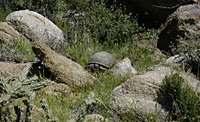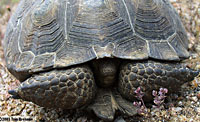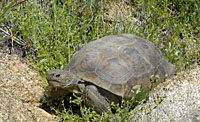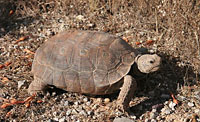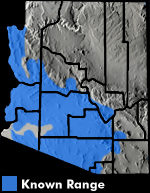Online Field Guide to The Reptiles and Amphibians of Arizona



Arizona
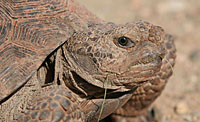 Arizona |
||
| SONORAN DESERT TORTOISE Gopherus morafkai | |
|
DESCRIPTION: A large (shell up to 380 mm or 15″ in length) land tortoise with a dome-shaped carapace (top part of shell) that is marked by distinct growth rings. Coloration can be horn, orange-brown, gray-brown, dark gray, or nearly black. The underside of the shell (plastron) is usually tan or yellow. The tail is short. The hind limbs are short, rounded, thick, and elephant-like. The forelimbs are flattened for digging, are longer than the hind limbs, and are armored with large, thick scales. The head is relatively small and rounded. In males the gular shields of the plastron extend out underneath the throat (see figure below).This tortoise has shorter gular shields and a more narrow shell-width than the similar looking Agassiz’s Desert Tortoise. DISTRIBUTION: This tortoise occurs along the western border south of the Colorado River and across most of southwestern and south-central Arizona at elevations ranging from near sea level along the Colorado River to just over 5,000′. HABITAT: Primarily an inhabitant of Arizona Upland Sonoran Desertscrub and Mohave Desertscrub but also enters Semidesert Grassland and Madrean Evergreen Woodland communities in some parts of the state. Across most of our state this tortoise inhabits rugged uplands such as rocky bajadas, hillsides, mountain slopes, and canyons. Populations in northwestern Arizona inhabit more moderate terrain such as gentle bajadas and low valleys. BEHAVIOR: Primarily diurnal and crepuscular but occasionally active into the night. The Sonoran Desert Tortoise is entirely terrestrial. It shelters and hibernates in self constructed burrows that are often excavated under large rocks. It uses its strong, paddle-like forelimbs to dig. Also shelters in naturally occurring cavities under rocks or in the banks of washes. When threatened it pulls the body and head into the shell and covers the opening with its thick, armored forelimbs. DIET: This herbivore feeds on grasses, herbs, cacti, tree shoots, and other plant material. REPRODUCTION: This tortoise mates from June through early August and lays a single clutch of up to 12 eggs the following June or July. The eggs are usually buried inside the burrow. By Thomas C. Brennan PROTECTED throughout Arizona |
|
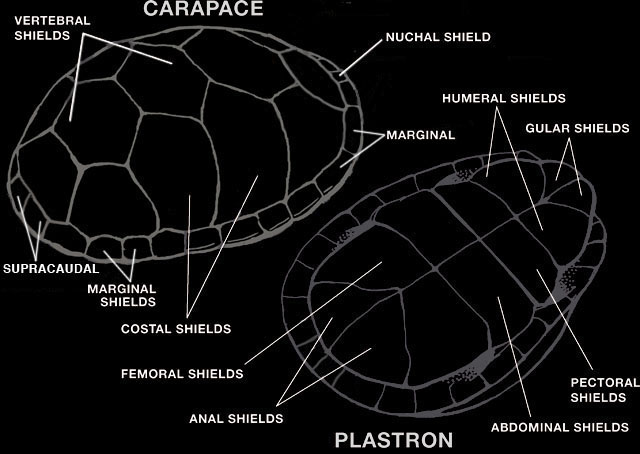
|
Brennan, T. C., & A. T. Holycross. 2006. A Field Guide to Amphibians and Reptiles in Arizona. Arizona Game and Fish Department. Phoenix, AZ Brennan, T. C., & A. T. Holycross. 2005. A Field Guide to Amphibians and Reptiles of Maricopa County. Arizona Game and Fish Department. Phoenix, AZ Stebbins, R.C. 1951. Amphibians of Western North America. University of California Press, Berkeley, CA. Stebbins. 1985. Western Reptiles and Amphibians. Houghton Mifflin. New York, NY Stebbins, R.C. 2003. A Field Guide to Western Reptiles and Amphibians, Third Edition. Houghton Mifflin Company, Boston, MA. |
|
Visit Partners in Amphibian and Reptile Conservation:


HOME
Copyright © 2023, Arizona Game and Fish Department. All rights reserved.
If you make use of the textual contents of this site in reports, publications, etc. please cite and credit the author(s) and photographer(s). All photos on this website are copyrighted. However, those found in the species account section may be used for any noncommercial scientific, educational, or conservation purposes provided that photographs are not altered and continue to bear the copyright symbol and name of the photographer. Please contact the photographer regarding commercial use of copyrighted photographs.










